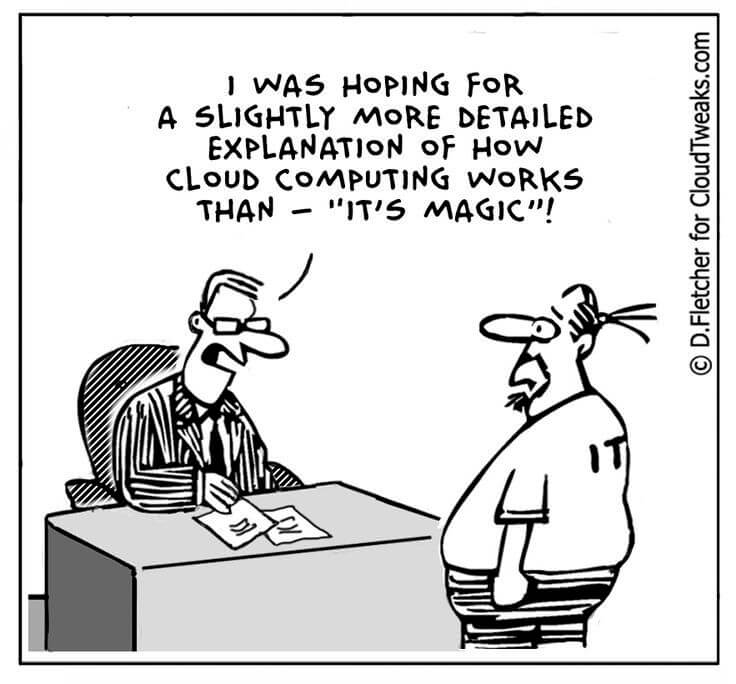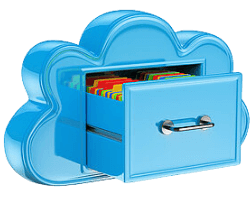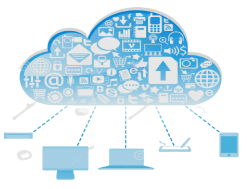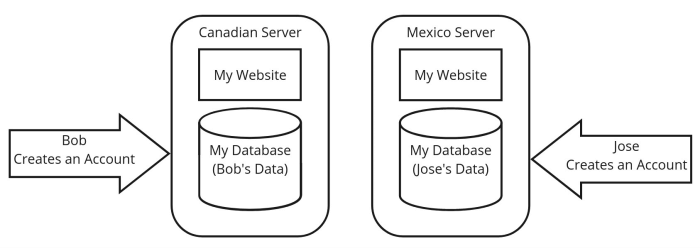Cloud Basics
We all live with it in one form or another. Some of us find them up in the sky while others find them down on their phones but where do Clouds come from and what is Cloud? How did they they get their name? In this Technology Explained article, I’ll answer all these questions and more in a way that will open your eyes to a world beyond the, pun intended, “clouds”.
Key Takeaways
- Cloud means nothing and everything
- Cloud Computing is online applications
- Cloud Storage is where your pictures go
- Cloud is Virtualization of Infrastructure (Hardware)
What We’ll Talk About
- How Cloud Got Its Name: As good an explanation as any
- Cloud Storage, Cloud Computing: The two categories that impact you most
- Did Cloud Exist Before Cloud: Would a cloud by any other name still be a cloud
- Can Cloud Help Your Business: I’ll provide you with all the questions you need to debate this subject
- Cloud Solutions vs Cloud Services vs Cloud Platforms: What’s the difference
- Being Cloud Native: The key to it all
How Cloud Got Its Name

A group of thinkers were sitting around, burning the midnight oil, trying to do the impossible. They wanted to connect the world and make information freely accessible. And, after a lot of thought, these brilliant minds came up with the solution. This network would be called the Internet and it was going to be glorious. All they needed was piles of money.
Meeting after meeting, they presented their brilliance in what could only be described as an alien language with drawings no better understood than ancient hieroglyphics. Then, one fine day, at the right place and the right time, the glazed look washed away from a single individual’s eyes and the lights began to flicker in the bulb above his head. Had communication been established?
For the first time, someone seemed to have caught a glimpse of the euphoria felt by these geniuses.
“Tell me again where these lines go? And, this box here? And, what about that circle there? And, where does all the data go? And these are digitalized you say… Tell me more”
It had began. The spark that begin years before was ready to flame into the World Wide Web but in that room, on that day, questions had to be answers and the glaze of confusion and doubt had to be wiped clean from this individual’s eyes.
Routers and gateways and nodes and packets and transmission protocols and parity bits and… Well, you get the idea but, if you want to up your buzzword game, have a look at this article: Tech Lingo To Up Your Game)
This was simply not going to get explained in a day and so our band of pioneers returned to their cave and tried to simplify their explanations by reducing much of the complexity, replacing the bulk of their intelligence with one simple hieroglyphic. Now their drawing contained a few houses, a bunch of lines resembling a web and a little – you guessed it – cloud hanging above it all.
The next meeting went a lot smoother, replacing many question with one simple inquiry.
Business Man: What's that one up there? Band of Pioneers: The fluffy thing? Business Man: Yes, that one. What is that? Band of Pioneers: It's where we'll store all the bits and bytes and stuff. It's where all the data lives and where all the magic happens Business Man: Ah. So it all lives in the cloud, you say? Band of Pioneers: (Look of confusion and desperation...) Yes, yes. That's exactly it. Business Man: (Smiles in satisfaction, having understood the complexity of it all) Yes - "The Cloud"
Alright, so I can’t prove that’s how the conversation actually happen but the truth is that neither can anyone else. Nobody can say with certainty when the term Cloud was first coined to describe something technical – and, don’t worry, we’ll explain what that technical bit is in just a minute but first if you want an accurate historical account of some of the coolest things that happened in the history of technology, check out this article on How IT Got Here And Where IT is Going.
Techies can argue all day long about where the term cloud came from and you’d find arguments supporting origins such as;
- 2006: When Google’s Eric Schmidt referenced Google Service as being in the Cloud somewhere
- 2001: When Silicon Valley blogger Dave Winer referred to the Internet as a Cloud of computers
- 1997: When a company (NetCentric) tried to trademark the term
- 1996: When executives at Compaq described the internet as one in which “Cloud Computing enabled Applications” would become commonly available via the web… Pretty good prediction.
But, the most widely accepted origin story really is quite similar to the one I’ve just told.
Telecom sales engineers who were overwhelmed at the idea of explaining the complexities of such technically advanced and ground breaking ideas, achieved their communication objectives by using over-simplified diagrams where a cloud was used to signify the resting place of data and its computational abilities.
This over-simplification might seem crud but was a necessary marketing approach to gain wide-spread adoption from the key parties that would eventually commercialize the internet. They showed commercial interest, the benefits of connecting these different facilities and people to these centralized, data facilities, which today, we call Data Centers.
Data Centers are where the web of rivers and streams lead to. They are the oceans that we access via our browsers, mobile devices, and eventually the chips in our heads.
There you have it –
The Cloud is simply a collection of computers we call servers, usually running Linux, stored in buildings we call Data Centers, usually found on the ground and not up in the sky.

Alright, lets get into what Cloud is meant to be
Key Cloud Offerings
Simply saying Cloud does not mean all that much. Its a quick way to describe a collection of functions but when we really get down into it, we’re really talking about 2 functions – Storage and Computing.
Cloud Storage

Cloud Storage as a marketing terms refers to storing data on online servers that are usually in a Data Center.
If you think of all the pictures you take with your Android or Apple phone, you’ll probably notice that those are backed up to “The Cloud”. In-fact this is what most people think about when they hear the word Cloud. In-fact a more correct way to express this would be to state that your pictures are backed up to Cloud Storage. I won’t be offended if you go ahead and take a moment to double check that all those precious pictures are properly backed up.
Cloud Storage is also often used to help websites with a lot of content though we usually call these CDNs or Content Delivery Networks. The basic idea is the same. Files are stored on online servers spread across the globe. This reduced the strain on any given server and makes the hosted solution more robust.
When you think about your emails, you can thank the makers of these storage Clouds. All those emails you’re intent on keeping until the day you die have to be accumulated somewhere. But don’t worry, Google is happy to hold on to them for you.
Cloud Computing

Cloud Computing similar to Cloud Storage in that they both are referring to doing or placing something on servers running somewhere else but instead of storing data, we’re talking about executing work or providing a service that runs on someone else’s computer.
Cloud Computing, generally, mostly refers to Cloud Services and when we talk about Cloud Services, we’re usually talking about things that have the acronym aaS after some other letter(s). These stand for “as a Service” and allow programs to no longer have to be run locally but instead can be accessed via a browser or other application, and have the bulk of their complexity sent out to a hosted, external service. The most popular Cloud Computing service is SaaS (Software as a Service) or which you can find a few examples bellow;
- Google Docs / Google Workspace
- SalesForce
- HubSpot
- Zoom
- MS Teams
- Slack
Cloud Computing as a term, also describes the a service offering of computational power capable of handling tasks you give it that don’t really look like the examples above.
Think about all that data your company has stored. What insights are you missing because you simply do not have the hardware needed to run through the data in multiple times, from different angles. This is what AI (Artificial Intelligence), is great at but it needs a lot of power to pull it off. Cloud Computing also offers that power as a service.
Did Cloud Exist Before Cloud

Techies that have been around long enough have a bit of an axe to grind with this whole idea of Cloud. This is because they see it as someone who plagiarized their work and changed the title.
You know now that Cloud was just a fluffy little drawing at the top of a complicated diagram expressing ideas so brilliant that the next closest technological advancement doesn’t come withing a light year of its impact. A necessary simplification? Perhaps. Let’s find out!
| Function in Question | Old Names | New Name |
|---|---|---|
| Online things | Hosted | Cloud |
| Data stored online | Online Backups NAS (Network Attached Storage) FTP Server | Cloud Storage |
| Having someone else’s computer(s) do work for you | Distributed Computing | Cloud Computing |
| Something as a service | Online Hosted | Cloud Service SaaS |
Ah but what about the fact that cloud makes everything easier and one can scale their applications with the click of a button and create new servers with just a few more clicks and… wait. Let’s not get lost in the details here but for the sake of argument, here’s a second more technical table to let the truth out
| What Cloud Does | What Was Before Cloud |
|---|---|
| Cloud is scalable and makes it easy to deploy new servers | This is called Virtualization and VMWare (example) started doing it in 2001 |
| I can deploy an application in minutes | These are called Containers, Images or Deployment Scripts and have been around for years |
| I can add as many resources as I want, anywhere in the world | All those resources are useless, if your code is not built for it. The principles of building code in this manner has been part of good practice since the 90s. Adding resources is part of Clustering technology which has been around since at least, 2004 |
| But, what about all that other technical magic | Yes, it has always existed and it has always been easy to use and difficult to setup correctly. And that is where you can win the argument supporting Cloud – The fact that someone else did it for you. |
I think, you’d have a hard time finding anyone who can defend an argument that Cloud in any form, is something new. Whether it gave common people a language to describe complex things, is up for debate but either way – try to give up such a friendly and cozy term like Cloud
Can Cloud Help Your Business

Whether you’re a start-up or large enterprise, you probably interact with some form of Cloud Storage or Cloud Computing. But, is it benefiting you? The answer is not as straight forward as you might have been made to believe. Most mature companies these days have some ongoing project labeled “Cloud Migration”. We know its a very marketable thing but is it the right thing for you?
The answer depends on the true reasons for the transition. Here are a few reason’s your IT teams will push for the move.
- Scalability
- Uptime
- Manageability
- Security
Let’s take these one-by-one and shed some truth on them
Cloud Solutions are Scalable

Imagine, you had a big room where you store all your client data as files. When you picked the room, it seemed impossible that it could ever fill up. Then, one day, there you are stacking folders in the very last inch of space.
As your business booms, you allocate a second room and eventually a third and now instead of looking in 1 room for a client’s file, you’re stuck trying to figure out what room the file is likely to be in. This is not a scalable data solution.
Now, imagine that, that 1st room could grow magically. How much easier would it be to find your files then?
Cloud Storage is considered scalable because it can grow to serve your needs and you never have to worry about the complexities of how it does it. To you, its always one big file room, with all your stuff.
Now, imagine that you have a situation where you need to look through all that data to make a single, important business decision. You leverage AI to get perspective but AI requires heaps of power to operate efficiently on your piles of data. You can go out an purchase a bunch of machines (servers) to accomplish the task and then be left with a bunch of expensive paperweights. Or, you can turn to the scalability features of Cloud Computing.
Now imagine a scenario where your entire business is based on AI. Would Cloud Computing still be beneficial or would it be cheaper in the long run, to buy those servers?
Remember, Cloud is just a marketing term. All the technology that makes Cloud things possible, already existed and has always been available.
When it comes to scalability and Cloud Services, the only question you need to answer is, how long will we need it for?
If you live in a city where you never need a car, you probably shouldn’t buy one. That day, you decide to hit the road, you can always rent one. In my opinion, this is the only factor that weighs in on the question of scalability.
Owning a car you very rarely use can be extremely costly.
Renting a car that you use every day is extremely costly.
Cloud Solutions Guarantee Uptime

Uptime is how long your service runs, uninterrupted. Online service providers use terms to express their promise of this. These terms refer to the percentage of time, the service should be up for during a given year. The gold standard is called Five Nines (99.999% Uptime) but the common reality is more like Five and a Half Nines (99.995%) which represents an average of 2.19 minutes of downtime in a month (or 26.30 minutes in a year).
The truth is that despite all the promises that providers make, interruptions happen. All 3 of the largest Cloud Platforms have gone down in the past and will go down in the future.
If your business has been impacted by down-time, you already know cost. Yes, up-time is important. But, should you run to Cloud solutions to solve your problem or is the problem simply that you need to find a more reliable hosting provider?
A well designed hosting solution that mirrors your services across two or more competing providers will decrease your chances of down-time more than migrating all your services to a single Cloud provider.
Cloud Solutions are More Manageable

To answer this one, we need to get our hands a bit dirty and dive into some technical stuff.
When the internet was first born, life was difficult. As technology progressed, doing cool things became simpler. Specifically, the complexity of IT infrastructure (machines, wires, bits, bytes, etc) become much simpler. Cloud Services leverage this simplifying technology to get your services up and running faster and make your IT life more manageable.
Have we finally found a key factor to tip the scales in favor of Cloud Services? Not necessarily. If your IT infrastructure is difficult to manage today, you may just end up transferring that difficulty to a new platform. If you “migrate”, your services from your current infrastructure to a Cloud solution without putting in some serious work to update them, you will simply migrate your problem from point A to point B.
Why are your services difficult to manage?
Cloud Services use the latest tools and to take full advantage of manageability benefits, you need to use those as well.
Now, if you upgrade your services to use the latest tools and migrate to the Cloud, was it the Cloud what made you more manageable? Or, your upgrades?
If you use the same management tools as Cloud Services, you will benefit from the same manageability. Thus, this benefit alone, does not grant Cloud Service a win.
Cloud Services are More Secure

Everyone is secure until they are not. I say this because if your IT teams uses security as a reason to move to the Cloud than something probably has already gone horribly wrong. Are Cloud Services more secure?
Security is a never ending battle and though the battlegrounds change, the battle continues.
Online security is quite simply a question of whether your soldiers are smarter than the attacking force.
Clearly AWS, GCP and Azure all hire the best soldiers so their defense is formidable and if you are leasing SaaS products, than the entirety of your safety is in their hands. But, simply hosting your services with Cloud providers does mean you’re safe. In-fact, most attackers don’t wage war on your infrastructure. They wage war on your services. Simply put, a large part of your defenses remain in the hands of your own soldiers.
Are Cloud Services more secure? Generally, when you’re using SaaS, yes because the SaaS provider includes security as part of the package (regardless of whether they use Cloud or not). But, when it comes to your proprietary tech, a large aspect of security remains in your hands.
It is however beneficial to have a portion of your security managed. You just have to ask yourself if the premium for this is worth it and the answer depends on the strength of the technical resources you choose to employ.
Should You Migrate to Cloud – Conclusion

I’m afraid a simple Yes/No is not forthcoming but do not fret. I did not set out to concretely answer that question for you. Instead, I wanted to shed some light on the subject so that you can hold your own debate.
Bellow, I provide a guide to help you in your future discussions.
| Problem | Questions to Ask |
|---|---|
| Our infrastructure is old an costly to maintain and its slowing us down | Are the applications that sit on top of our infrastructure detached from the infrastructure itself – are they Cloud Native? What would be involved in the upgrade of our current systems |
| We’re running out of resources | Are we correctly utilizing what we have? Can evaluate our inventory of applications and their benefits? Can’t we simply add more resources? |
| Our services crashed due to overwhelming demand | If this is the new norm, we need to ask if we’re running out of resources but if it is a spike, we need to know how often it’ll happen so we can determine if its worth upgrading our hardware or sending the peak traffic to a Cloud Service. |
| We’re using a fraction of our infrastructure and its costly | Why do we need so much hardware? Do we we ever come close to using it all and if so, how often do these spikes occur? (Then, reference the problem above) |
| Our website had a breach | How would security do Cloud Services offer that would have prevented this? What is the cost of implementing that mitigation on our current systems? |
| Our hosting provider keeps going down | What better hosting provider are out there and what would be the cost of migrating our solution to them vs migrating to a Cloud Service provider? |
| Its costly to manage all these applications | Any tool we use to built our business, is not our business. Unless their is a significant advantage to managing these tools, lets let someone else do it. After all, it is their business, and we have ours to run |
Important
Throughout all these questions, always attempt to estimate the cost of upgrading your current solutions vs migrating to Cloud Services. Cloud Services tend to be far more costly and sometimes absorbing your one-time upgrade cost is more beneficial in the long run. You already know that you’re using technology as a tool to serve your business need. Just avoid chasing technology for the sake of technology. The end result is what counts.
Cloud Solutions vs Cloud Services vs Cloud Platforms
If you were paying close attention, you might have noticed that sometimes I use the term Cloud Services and sometimes I use Cloud Solutions. I bet you thought I was just a bad writer and you’d be correct on that point but on this specific aspect, it was by no mistake. Their is a distinction. And, in-fact, we’ll even talk about Cloud Platforms.
Cloud Solutions
This describes what you get from modern infrastructure technology where the desired outcome is always to hide the hardware complexity layer and offer all its abilities as an abundance of virtual resources.
- Need more Hard Drives? We simply call it storage now. Login to your web control panel and move the slider to the right
- Need more RAM? We call that memory. Move that slider to the right.
- Want a copy of your website in Mexico to offer faster speeds to that demographic? Click here on the map and select deploy
It really is that simple but only if your programs are Cloud Native.
Cloud Platform
Cloud Solutions talk about what you’re getting while the Cloud Platform describes the bundle of technology that makes that offering possible. AWS, GCP and Azure all have their own proprietary Cloud Platforms that use a variety of technology, some of which they created and some of which they didn’t.
When we talk about Cloud Platforms or Cloud Services, its always the same 3 that come to mind but their are others.
OpenStack is the most popular Cloud Platform that you can use to setup your own Cloud Solution for your business. Its fully Open Source (free) and extremely powerful. Businesses wanting Cloud Solutions without risking privacy, often setup their own Cloud Solutions using this Cloud Platform. Other businesses, offer hosted Cloud Services based on this platform.
Cloud Services
Now that you understand Cloud Solutions and Cloud Platforms, Cloud Services is relatively simple. It is simply a hosted and platform maintained, offering of Cloud Solutions
Being Cloud Native

In a traditional approach, your application sits on top of an operating system and uses other applications within that system to run. This is called a stack. If you want to dig deeper into this stack stuff, check out “Full-Stack, Front-End, Back-End And All The Other Ends“.
If you remember, I mention that the primary objective of Cloud Solutions is to remove the complexity of infrastructure and let see it all as some simple library of available resources. But when we take our example of scaling out our website Mexico with the click of a button, we are faced with a few issues.
- Can our website exist in 2 places at once?
- Can our website install itself automatically in the second location?
- Can I delete my site from the second location without impact?
These are the question solved making applications “Cloud Native” and if you have not achieved this, than it is unlikely that Cloud Services will benefit you all that much. Applications that are not “Cloud Native” can not benefit from Auto-scaling (the handle spikes and only use what you need) and single-click deployments; just to list a few.
If your applications exist on an infrastructure where they are fully dependent on the right Operating System being installed with all the correct dependencies, it is not portable and thus are simply migrating to any Cloud is futile.
Here’s simple example:

Because your, lives with your website, when you deploy a new copy of the site, you need to deploy a new database and these 2 are not in-sync. Bob can’t login from Mexico and Jose can’t login from Canada and you’ve created the perfect mess.
We won’t go into solutions here since our objective is to provide you with the right questions to ask but know that being Cloud Native is the key to benefiting from Cloud Solutions.
Do you disagree with my explanation of these fluffy Clouds? I love a good debate and want to hear from you. Reach out to me on LinkedIn and mention this article.
